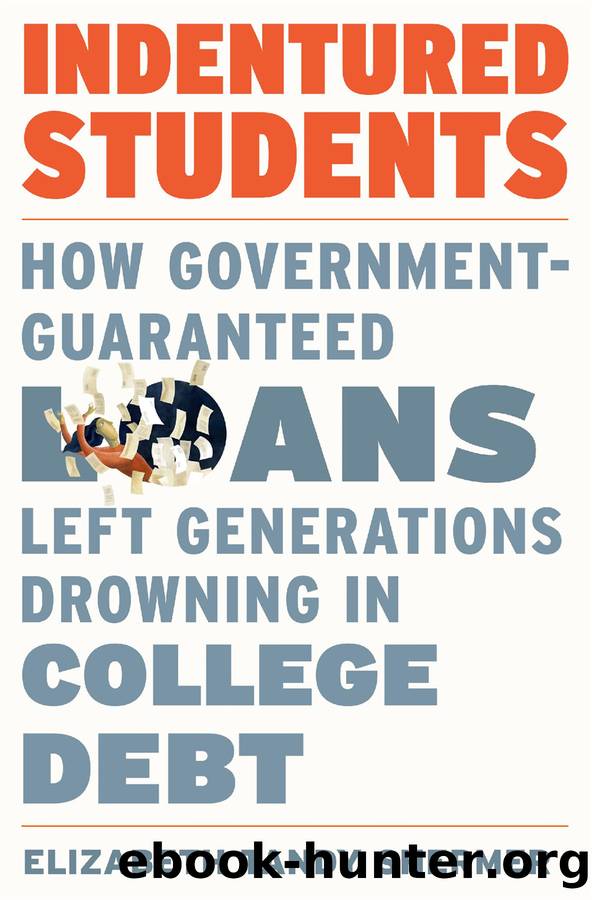Indentured Students: How Government-Guaranteed Loans Left Generations Drowning in College Debt by Elizabeth Tandy Shermer

Author:Elizabeth Tandy Shermer [Shermer, Elizabeth Tandy]
Language: eng
Format: epub
Tags: Business & Economics, education, Educational Policy & Reform, Federal Legislation, history, United States, 20th Century, political science, Public Policy, Economic Policy, Social Science, Social Classes & Economic Disparity
ISBN: 9780674251489
Google: i4o0EAAAQBAJ
Publisher: Harvard University Press
Published: 2021-08-03T00:17:21.248524+00:00
A Right to Education, or Financing Floor for It?
Education experts, however, feared there would be no room for college hopefuls in the early 1970s, when top researchers warned of, as Berkeley professor Earl Cheit titled his landmark 1971 study, âThe New Depression in Higher Education.â Some scholars considered the Ford Foundation and Carnegie Commission on Higher Educationâsupported study to be âinaccurate and alarmistâ but even Cheitâs sharpest critics admitted college finances had long been shaky. New Dealers had little interest in directly bailing out universities decades before Kennedy College undergraduates struggled to get attention from reporters and lawmakers in the midst of HEAâs 1968 reauthorization. Just three years later, Cheit noted, âaccounts of the financial plight of schools are now front-page stories and the subject of concerned editorials.â He cited seventy references to precarious academic finances published between 1967 and 1970, when some campuses closed, made cuts, reallocated resources, or even operated in the red. He uncovered that many institutions faced serious financial issues. In 1970, 42 percent seemed headed for trouble and another 19 percent already faced difficulties. Public institutions tended to have the surest financing: 50 percent were considered solvent. Private colleges and universities faced more dire circumstances. Only 28 percent were not currently in financial straits, slightly less than the proportion of solvent liberal arts institutions. Small colleges actually fared better than universities, only 19 percent of which were fiscally sound.5
Most blamed insolvency on not enough government, particularly federal, investment. Such accusations exemplified how much had changed since the elite âschool crowdâ fought the Roosevelt administration during the Great Depression. Expenditures had dramatically increased in the twenty years after Sputnikâs 1957 launch; state appropriations had quadrupled in the 1960s. However, revenue streams rose far slower after 1967, which only exacerbated the feverish competition for research grants, donors, government allocations, and students. The number of college-age Americans leveled off in the early 1970s. Many administrators desperately needed their tuition payments because colleges and universities did not benefit equally from the seemingly substantial 207 percent increase in federal earmarks between 1968 and 1977. In those years, the portion of overall higher education revenue made up by federal allocations plummeted from its mid-1960s surge (see appendix, figure A1). That drop partly reflected government research support shrinking from $5 billion to $4.7 billion between 1968 and 1974. Even scholarships began to disappear. By 1974, 15 percent of doctoral students borrowed. Legislators contributed a larger share of the academyâs revenue in these years but states continued to vary widely on how much they allocated. Legislators generally tended to direct more money toward community colleges and financial assistance programs while providing slightly less support to public colleges. Plus, the state boards and agencies overseeing higher education only received a little more money in years when public research universities saw a noticeable drop in support (from 54 percent to 46 percent). Such cuts left many institutions scrambling to live up to their varied uses and obligations, as former UC president, then Carnegie Commission on Higher Education head Clark Kerr pointed out in the early 1970s.
Download
This site does not store any files on its server. We only index and link to content provided by other sites. Please contact the content providers to delete copyright contents if any and email us, we'll remove relevant links or contents immediately.
Harry Potter and the Goblet Of Fire by J.K. Rowling(3134)
Never by Ken Follett(2950)
Shadow of Night by Deborah Harkness(2776)
Ogilvy on Advertising by David Ogilvy(2723)
Zero to IPO: Over $1 Trillion of Actionable Advice from the World's Most Successful Entrepreneurs by Frederic Kerrest(2525)
Machine Learning at Scale with H2O by Gregory Keys | David Whiting(2360)
The Man Who Died Twice by Richard Osman(2338)
Book of Life by Deborah Harkness(2304)
How Proust Can Change Your Life by Alain De Botton(2284)
My Brilliant Friend by Elena Ferrante(2261)
0041152001443424520 .pdf by Unknown(2247)
The Tipping Point by Malcolm Gladwell(2220)
How to Pay Zero Taxes, 2018 by Jeff A. Schnepper(2125)
Will by Will Smith(2112)
Hooked: A Dark, Contemporary Romance (Never After Series) by Emily McIntire(2032)
Purple Hibiscus by Chimamanda Ngozi Adichie(2017)
Borders by unknow(1805)
Rationality by Steven Pinker(1796)
Daughter of Smoke and Bone by Laini Taylor(1766)
